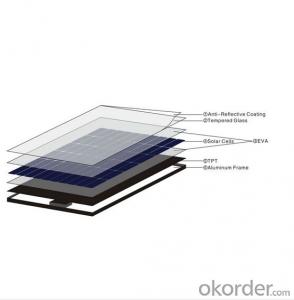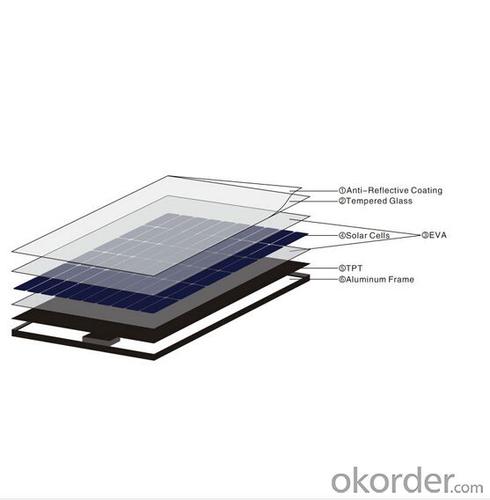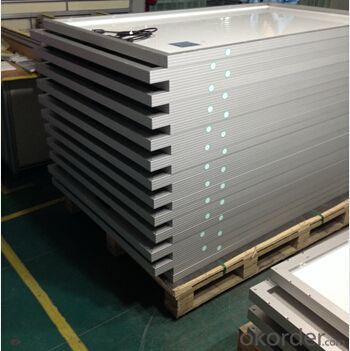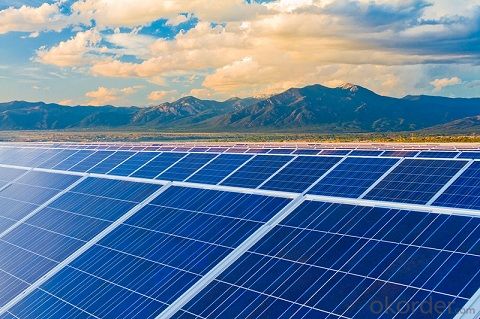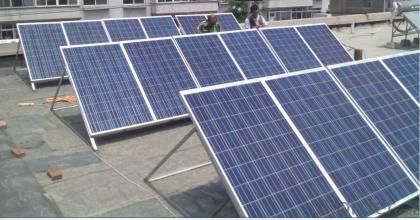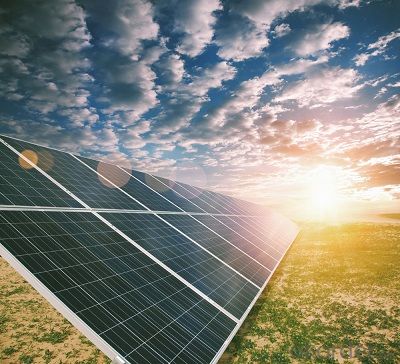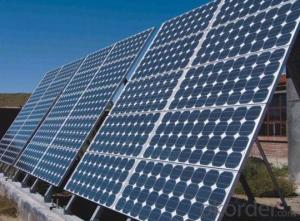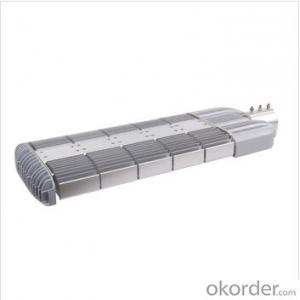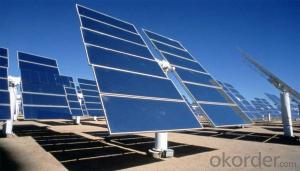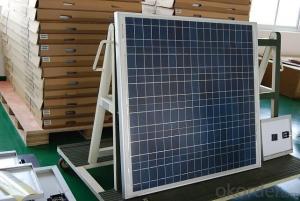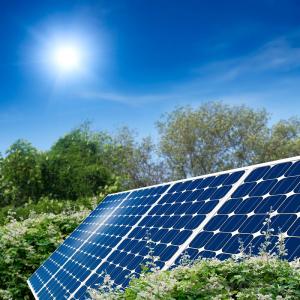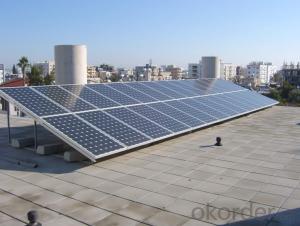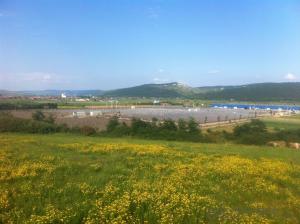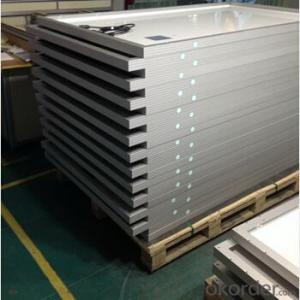Portable Solar Panels With Battery - CNBM Solar Monocrystalline 156 Series 45W
- Loading Port:
- Shanghai
- Payment Terms:
- TT OR LC
- Min Order Qty:
- 1000 watt
- Supply Capability:
- 20000000 watt/month
OKorder Service Pledge
OKorder Financial Service
You Might Also Like
Specification
Materials
Silicon
Guarantee
12 yrs free from defects in materials and workmanship
No less than 90% within 10yrs and no less than 80% within 25yrs
TUV(IEC61215&IEC61730), CE, UL
Application
Photovoltaic/ solar/ green energy/ energy saving
Descriptions
1.High efficiency crystalline silicon solar cell. Even if under the weak light, the solar module can produce maximum power output.
2.Tempered glass (toughened glass): Anti-reflecting coating and high transmission rate glass increase the power output and mechanical strength of solar module.
3. EVA and TPT: Using high quality EVA and TPT to prevent destroying and water.
4. AI frame: Without screw, rner connection. 6 holes on the frame can be installed easily.
5. Junction box: Multi function junction box with water proof.
6. Long lifetime: ≥25 years; Less power decrease.
7. Good performance of preventing from atrocious weather such as wind and hails.
8. Resisting moisture and etching effectively, not effected by geology.
9. The certificate issued by international authority: UL, TUV, IEC, CE.
Packaging Details
26pcs/pallet, 28pallets/ 40HQ
Our solar panels are packed in cartons, and then pallet.
Shipping by sea or by air are both ok, it up to customer’s chose.
We’d like to inquiry the freight cost for customer after be informed exact quantity and destination address.
CNBM International Corporation is a professional solar panel manufacturer in China for CNBM brand . Silicon panel ( silicon module), as our main product, has high quality and good service. Our products are very popular in Europe, Australia, England, Middle East, Mexico, Argentina, Chili, Singapore and Africa.Furthermore, our products have gained international authorized certificates like TUV, UL and CE.
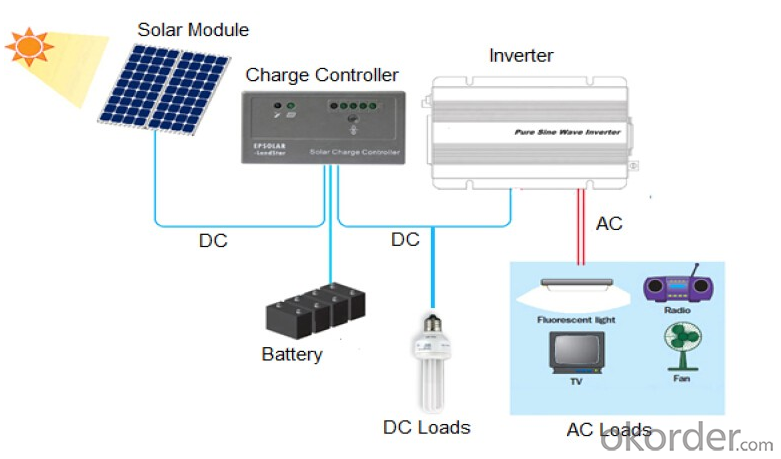
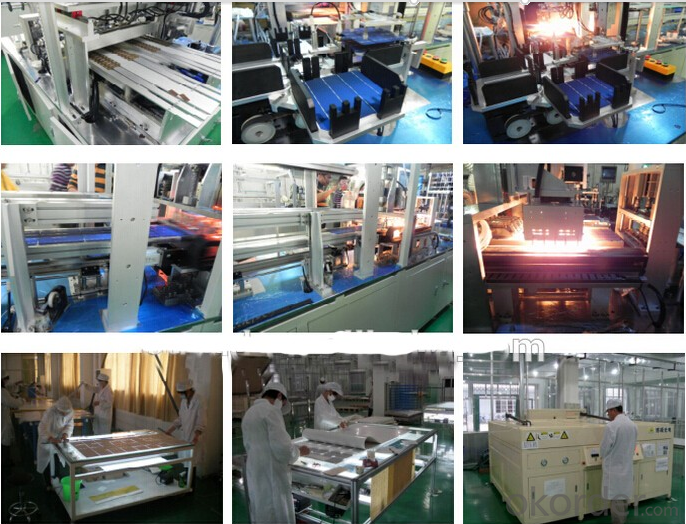

Why Choose Us
A. Professional Manufacturers , Strict quality control & power classification Silicon Solar PV Module
B. 100% A grade solar cell with Positive tolerance power range.
C. High Conversion Efficiency , High transmission rate , low iron tempered Anti-reflecting/coating film 3.2mm glass
D. Anti-aging & high visosity EVA
E. high frame resistant & Double-sided fluorine TPT
F. Anodized aluminum alloy high thickness frame
G. 3 or 6 bypass diodes , 90mm 4m2 cable , MC4 connectors & waterproof junction box
H. Long life, Easy installation, high wind & hail impact resistance
I. Be resistant to atmospheric exposure & effects of delamination
J. ISO9001:2008/ISO14001:2004/OHSAS18001:2007/ CE /TUV/CEC/ IEC/EN61215 IEC/EN61730/CHUBB INSURANCE
K. 10Years Manufacturing Quality Warranty , 10Years 90% Power output Warranty, 25Years 80% Power output Warranty
- Q: Are there any disadvantages to using solar panels?
- Yes, there are a few disadvantages to using solar panels. Firstly, the initial installation cost can be relatively high, making it a less affordable option for some individuals or businesses. Additionally, solar energy production relies on sunlight, which means that solar panels are less effective during cloudy or rainy days, or at night. This intermittency requires a backup energy source or energy storage system, adding to the overall cost. Moreover, solar panels require a significant amount of space for installation, which may not be feasible in densely populated areas. Lastly, the manufacturing process of solar panels can have environmental impacts, as it involves the use of certain materials and chemicals. However, it is worth noting that continuous advancements in technology are reducing these disadvantages, making solar panels an increasingly viable and sustainable energy solution.
- Q: I have to get a lot of information on how solar panels are developed and distributed in America because I have to do two pages on this. Please help me get information in this I really need it!! Thankss...
- The first link below is one of the best sites for recent news about solar panels. You should be able to find stories about solar panels under development today. A little bit of the history: Solar panels have been around for about 50 years now. They were first used to power spacecraft. Solar power for domestic use started to develop rapidly in the 970's during the first oil crisis, but as energy prices fell in the 980's solar development slowed. Most of the large solar panel makers were purchased by large oil companies who seemed not to be too interested in solar. In the late 990's as concerns about both Peak Oil and Global Warming grew there was renewed interest in solar power and a number of new companies were started to develop new kinds of solar panels. Many of these new companies have grown larger than the older solar companies still owned by big oil companies. Over the last 7 years or so growth in the solar market has been explosive with a compound growth rate of almost 40% per year. In 2005 the solar industry for the first time started to consume more silicon than all other electronic industries combined resulting in a world wide silicon shortage that is still with use. New silicon refineries are coming on line and the shortage is expected to diminish by 2008 or 2009. Check out the two links below. They will help you a lot.
- Q: How do solar panels impact wildlife?
- Solar panels can have both positive and negative impacts on wildlife. On the positive side, solar panels provide clean and renewable energy, reducing dependence on fossil fuels and mitigating climate change, which can have indirect benefits for wildlife populations. Additionally, solar panels can create new habitats for certain species, such as birds, by providing perching and nesting opportunities. However, there are also potential negative impacts to consider. Solar farms can disrupt and fragment natural habitats, displacing or causing harm to certain species. Birds may be at risk of collision with solar panels, although proper installation and design can help mitigate this issue. To minimize these negative impacts, it is important to carefully plan and design solar projects, taking into account wildlife conservation and habitat protection measures.
- Q: if I have a battery bank of of 6 L-6 Trojan batteries, 6V 390AH, wired in series parallel to give me 2V at 70AH (or 4,040WH) what kind of solar panels should I purchase assuming I have 8 hours of sunlight, a solar tracking system and I want to make sure I can fully recharge my batteries everyday if i use up all the power every night?i understand there are efficiency issues to consider which i have not calculated in yet. thanks.
- Hi okorder /
- Q: Can solar panels be used for satellite communication?
- Yes, solar panels can be used for satellite communication. Solar panels are often used to power satellites as they can convert sunlight into electricity. This generated electricity can then be used to operate various communication systems and equipment on board the satellite, enabling satellite communication.
- Q: What would these solar panels power? For instance, my energy bill shows 2035kWh for last month. How much would this remove from that if it outputted full power? Thanks!
- A solar panel that is rated at 60 watts would produce that amount under the most favorable conditions of direct sunlight at noon in a good location. This would taper off to nothing at the beginning and ends of the daylight. A 60 watt Panel operating at full output for hour would produce 60 watt hours. If we assumed a straight line of output from zero to 60 watts and back to 0 again over 6 hours the average output would be 30 watts x 6 hours = 80 watt hours / day x 365 days = 65700 watt hours in a year / 2 = 5475 watt hours in a month. You lose about 0% converting from DC to AC. This reduces this to about 4927.5 watt hours. Your bill is measured in KW hr which are 000 times bigger. This is 4.9275 KW hr or .24% of your last month's bill. At a national average of about $.2 per KW hr the energy out put for one month would be equal to about 60 cents.
- Q: I thought that I had a fairly good understanding of watt's law, but i'm starting to doubt myself.If I have a load of 4500watts at 240 volts, how many watts of solar panels do I need, if the solar panels are at 2v?Yes, Yes... I have a charge controller, batteries, etc...So the way I looked at this at first:watts = volts * amps For the load4500 = 240 * xx would be 8.75aFor the power source (each solar panel)00 = 2 * xx would be 8.3a8.75 / 8.3 = 2.25, rounded up = 3So... based on that I came to the conclusion that I needed 3 solar panels...But... then I was thinking. Does it work that way?Or do I need 4500 / 00 = 45, aka 45 solar panels?In other words...If I have a 2v power source, how many watts do I need to drive a load of 4500w at 240v?ThanksMatt
- The easy way is to just use the power values. You need 4500W. Each solar panel delivers 00W (from a value in your working). Therefore you need 4500/00 = 45 solar panels. This is a crude calculation, ignoring efficiencies, voltage conversion losses and losses due to internal resistance. You would probably need quite a few more than 45 panels. ___________________________ I'll explain how to do the calculation your way. Each solar panel delivers 00W with a voltage of 2V. So the current is 00/2 = 8.333A. Each solar panel delivers 8.333A at 2V. But you require 8.75A at 240V panel delivers 00W. To get 4500W, you need: 8.75/8.333 = 2.25 times more panels to increase the current AND 240/2 = 20 times more panels to increase the voltage. So overall you need 2.25 x 20 = 45 panels. Of course if the power output of each solar panel is not 00W, you have to change the above calculation accordingly.
- Q: I live in a higher LATITUDE so in the winter months, there is a limitation in the amount of sunlight available, but will this impediment restrict the ability of solar panels to function due to the lack of sunlight involved?
- You can learn to create a system to Harvest solar energy in the heat form. To many people are focusing on electrical generation.Solar Heat from the Sun is easier to gather from the sun.It requires no power once installed due to the Fact that heat rises .A multiple of applications of heat collection exist since the 960's.
- Q: How much per sq inch do they cost? Will i have to worry about them blowing off during hurricane season? If the sun isnt out for a week will my power go out? Will I have to check them every week and check which ones arent working and replace them? Is there anyway for them to be damaged by acid rain or any type of erosion like hail? When do I have to replace them? How do I dispose of old ones (like recycling)? What is smarter and more economical having few big panels or many small ones? I know I have alot of questions but I want a good detailed answer.
- What's your Source (Optional)
- Q: Are there any restrictions on installing solar panels in certain areas?
- Yes, there can be restrictions on installing solar panels in certain areas. These restrictions can vary depending on local regulations, zoning laws, homeowners' association rules, and building codes. Some areas may have height restrictions, setback requirements, or aesthetic guidelines that limit the placement or visibility of solar panels. Additionally, historic districts or areas with protected landscapes may have stricter regulations. It is important to check with local authorities and consult any relevant guidelines or permits before installing solar panels in a specific area.
Send your message to us
Portable Solar Panels With Battery - CNBM Solar Monocrystalline 156 Series 45W
- Loading Port:
- Shanghai
- Payment Terms:
- TT OR LC
- Min Order Qty:
- 1000 watt
- Supply Capability:
- 20000000 watt/month
OKorder Service Pledge
OKorder Financial Service
Similar products
Hot products
Hot Searches
Related keywords
